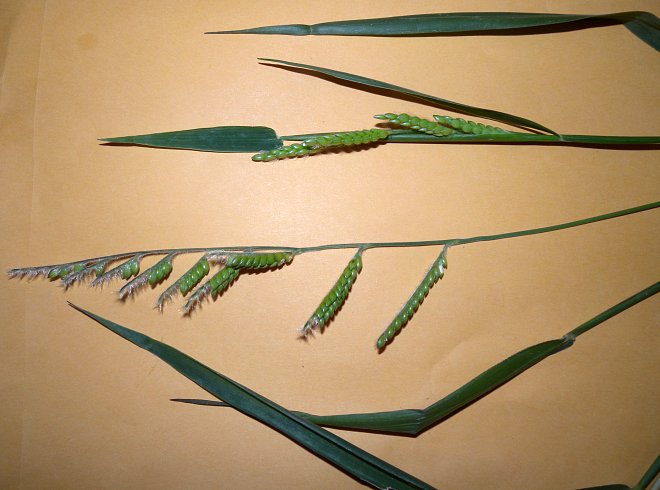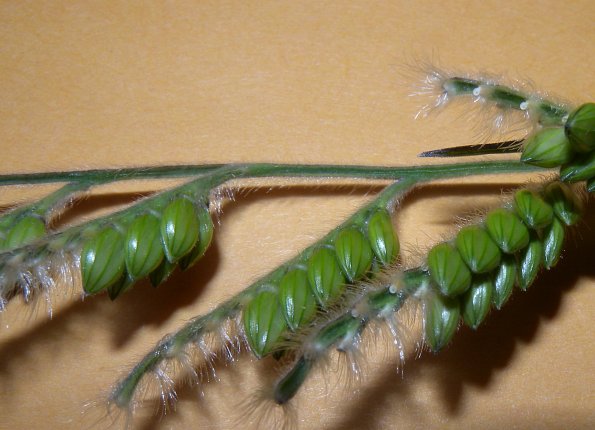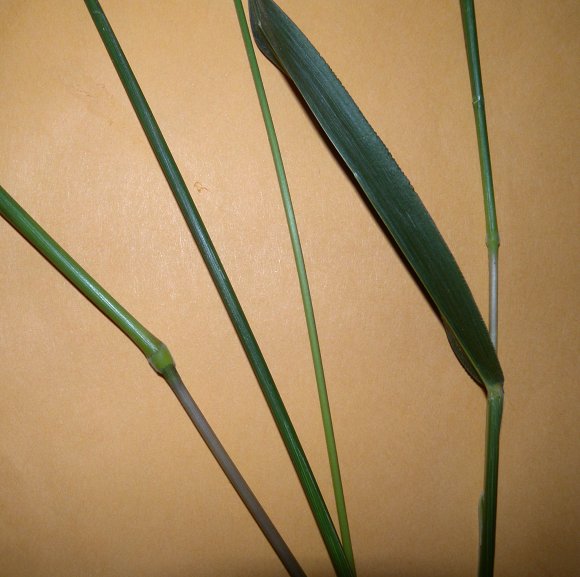
Each raceme has a secondary rachis above and 2 rows of partially overlapping spikelets below. The spikelets have short pedicels (about 0.5 mm. in length) that are densely villous. Relative to their secondary rachises, these spikelets are ascending. The secondary rachises themselves are angular and densely villous. Each spikelet is 4.5–5 mm. long, about 2.5–3 mm. across, and single-flowered; it is broadly ellipsoid and slightly flattened in shape. Each spikelet has an outer glume, a sterile outer lemma, a fertile inner lemma with a perfect floret, and a small callus at its base. Both the outer glume and outer lemma are the same length as the spikelet; they are broadly elliptic in shape, convex along their outer surfaces, light green, 5-veined, and glabrous to sparsely short-pubescent. The inner lemma is about 3.5–4.5 mm. in length and hardened. The blooming period occurs from mid-summer to early autumn. The florets are cross-pollinated by the wind. Afterwards, individual spikelets disarticulate below their glumes as they become mature. The grains of these spikelets are 3–4 mm. long, broadly ellipsoid in shape, and partially flattened along one side. The root system is fibrous. This grass reproduces by reseeding itself.

Cultivation: The preference is full or partial sun, more or less mesic conditions, and fertile loamy soil. In Illinois, this grass is an annual. Growth and development begins after danger of hard frost during the spring, and continues through the summer. Because this grass has a C4 metabolism, it is able to withstand periods of hot dry weather. It is potentially invasive.
Range & Habitat: Hairy Cup Grass has been found primarily in NE Illinois and scattered counties elsewhere (see Distribution Map). This grass is uncommon in Illinois, although it may be spreading. It is native to Eurasia, its range extending from eastern Europe to Japan. Hairy Cup Grass was probably introduced into North America from contaminated shipments of grain or by other accidental means. In the Midwestern states, this grass has become more common during the past 20 years and it appears to be spreading. Habitats consist of cropland (primarily corn fields) and roadsides. This grass was also found along the edge of a prairie restoration in Urbana, Illinois. Habitats with a history of disturbance are preferred.

Faunal Associations: At the present time, little is known about floral-faunal relationships for this non-native grass in North America. Hairy Cup Grass (Eriochloa villosa) is listed as one of the host plants for the caterpillars of a polyphagous moth, the Stalk Borer (Papaipema nebris); see Rice & Davis (2010). The grains of this grass are consumed by some species of crickets (e.g., Gryllus pennsylvanicus) and ground beetles (e.g. Harpalus pensylvanicus); granivorous songbirds and rodents also feed on the grains (Simard et al., 2013). Agricultural machinery and vehicles probably spread the grains to new locations.
Photographic Location: The specimen was collected from the edge of a prairie restoration in Urbana, Illinois. It was photographed indoors.
Comments: This non-native grass is a relatively recent introduction into Illinois. Other cup grasses (Eriochloa spp.) in Illinois are adventive from the Great Plains and western states, and they are also uncommon within the state. Hairy Cup Grass (Eriochloa villosa) can be distinguished from other cup grasses within the state by its stouter spikelets and villous rachises and pedicels. It also resembles some species of native bead grass (Paspalum spp.), however its racemes of spikelets occur along only one side of the primary rachis, rather than two sides, and its rachises and pedicels are more villous (covered with long soft hairs). Another common name of this grass is Woolly Cup Grass.